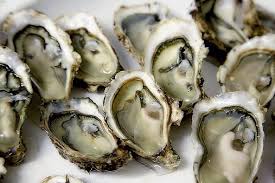Oysters are a type of shellfish that are highly valued as a delicacy and a source of nutrition. They are found in both freshwater and saltwater environments, and are typically harvested for human consumption.
Oysters are filter feeders, meaning that they extract nutrients from the water by filtering it through their gills. This process helps to purify the water and remove pollutants. Oysters are also rich in protein, vitamins, and minerals, and are low in fat and calories.
Oysters are commonly served raw on the half-shell, but can also be cooked in a variety of ways, including fried, grilled, baked, or roasted. They are often accompanied by a variety of condiments, such as lemon, hot sauce, cocktail sauce, or mignonette sauce.
In addition to their culinary uses, oysters also play an important ecological role by providing habitat for other marine species and contributing to the overall health of marine ecosystems. However, overfishing and habitat destruction have put many oyster populations at risk, making sustainable harvesting practices crucial for the long-term health of these valuable creatures and the environments they inhabit.
Read Also: How to Hatch Snail Eggs Successfully in Snail Rearing
Description of Oysters

The oyster’s body is soft and fleshy, and contains a muscular foot that it uses for movement and anchoring itself to surfaces. Oysters also have two gills that they use to filter water and extract nutrients. Their digestive system consists of a mouth, stomach, and intestines.
The size of an oyster can vary depending on the species, but they generally range from 3-4 inches in length and 1-2 inches in width. Some species of oysters can grow much larger, with some reaching up to 12 inches in length.
Oysters can be found in a variety of habitats, including rocky shores, muddy bottoms, and shallow waters along coastlines and estuaries. They are usually found in clusters or beds and can be farmed or wild-caught for commercial purposes.
Health Benefits of Oysters

Rich in nutrients: Oysters are high in a variety of nutrients, including protein, zinc, iron, copper, vitamin D, vitamin B12, and omega-3 fatty acids.
Boost immune system: Oysters contain high levels of zinc, which is essential for a healthy immune system.
Low in calories: Oysters are low in calories, making them a great addition to a healthy diet.
Improve heart health: The omega-3 fatty acids found in oysters may help reduce the risk of heart disease by lowering cholesterol levels and reducing inflammation.
Good for eyesight: Oysters are a good source of vitamin A, which is important for maintaining good eyesight.
Promote bone health: Oysters are high in calcium and phosphorus, which are essential for building and maintaining strong bones.
Enhance brain function: Oysters are rich in vitamin B12, which is important for healthy brain function.
Aid in digestion: Oysters contain high levels of zinc, which is essential for healthy digestion.
Reduce stress and anxiety: Oysters contain high levels of zinc, which can help reduce stress and anxiety.
Boost energy levels: Oysters are a good source of iron, which is important for maintaining healthy energy levels.
Improve skin health: Oysters are high in zinc and vitamin A, which are important for maintaining healthy skin.
Reduce inflammation: The omega-3 fatty acids found in oysters can help reduce inflammation in the body.
Support thyroid function: Oysters are a good source of iodine, which is essential for healthy thyroid function.
Boost fertility: Oysters contain high levels of zinc, which is important for healthy reproductive function.
Enhance muscle growth and repair: Oysters are high in protein, which is essential for muscle growth and repair.
Aid in weight loss: Oysters are low in calories and high in protein, making them a great food choice for weight loss.
Reduce the risk of certain cancers: The zinc and selenium found in oysters may help reduce the risk of certain types of cancer.
Improve sexual health: Oysters have been traditionally considered an aphrodisiac, and may help improve sexual health and function due to their high levels of zinc.
Read Also: Health Benefits and Uses of Mussels
Uses of Oysters

Culinary: Oysters are prized for their delicate flavor and are commonly consumed raw or cooked in various dishes. They are often served as appetizers or used in soups, stews, and pasta dishes. Oysters are also a popular ingredient in sushi and other seafood dishes.
Nutritional: Oysters are a rich source of nutrients, including protein, iron, zinc, and vitamins B12 and D. They are also low in fat and calories, making them a healthy food choice.
Environmental: Oysters are filter feeders, meaning they help to clean the water in which they live. This makes them an important part of the ecosystem and a valuable tool in improving water quality.
Aquaculture: Oysters are commonly farmed for commercial purposes. Oyster farming involves cultivating oysters in shallow water or on artificial reefs, allowing them to grow and mature for several months before harvesting.
Cultural: Oysters have played an important role in many cultures throughout history. They have been used as currency, a symbol of wealth, and a source of inspiration for art and literature.
Medical: Oysters are believed to have several health benefits, including boosting the immune system, improving brain function, and reducing the risk of heart disease.
Additionally, oysters are a versatile and valuable resource with many uses in culinary, nutritional, environmental, aquaculture, cultural, and medical fields.
Preparation of Oysters

Raw oysters: Raw oysters are typically served on the half shell with a squeeze of lemon juice or a dollop of mignonette sauce. Some people also enjoy them with horseradish, cocktail sauce, or hot sauce. To shuck raw oysters, you’ll need an oyster knife and some practice. Hold the oyster flat-side up in one hand and insert the knife at the hinge, twisting the blade to pop it open. Cut the muscle attaching the oyster to the shell, and remove any debris before serving.
Steamed oysters: Steamed oysters are a popular preparation method in Asian cuisine. To steam oysters, place them in a steamer basket or on a heatproof plate over a pot of boiling water. Cover and steam for 5-8 minutes, or until the shells open. Serve with soy sauce, sesame oil, or other dipping sauces.
Grilled oysters: Grilled oysters are a popular Southern dish that can be prepared on a barbecue grill or in the oven. To grill oysters, shuck them and place them on a grill rack or baking sheet. Top each oyster with a pat of butter, garlic, and herbs, and grill for 5-7 minutes, or until the edges start to curl and the butter is melted.
Fried oysters: Fried oysters are a popular appetizer or sandwich filling in many cultures. To fry oysters, dredge them in flour or cornmeal and fry in hot oil for 2-3 minutes, or until golden brown. Serve with tartar sauce, cocktail sauce, or hot sauce.
Baked oysters: Baked oysters can be stuffed with a variety of ingredients, such as spinach, breadcrumbs, cheese, and bacon. To bake oysters, shuck them and place them in a baking dish. Top with the desired stuffing and bake at 400°F for 10-15 minutes, or until the topping is golden brown and the oysters are heated through.
No matter how you choose to prepare oysters, it’s important to handle them safely to avoid foodborne illness. Always purchase fresh oysters from a reputable source, and refrigerate them at 40°F or below until ready to use. Discard any oysters with cracked or open shells, and cook them thoroughly before consuming.
Read Also: How to Treat a Viral Fever at Home

